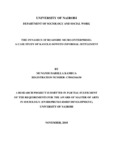| dc.description.abstract | Kenya’s informal sector has over the years grown faster than the formal sector. Eventually, observed today is that the micro-enterprise (ME) sector of Kenya has the largest number of establishments in the Country (MSME, 2016). Therefore, so long as the factors that have contributed to this fast growth persist, the likelihood of an expanded informal ME sector in the future seems inevitable. This is the reality for Kenya. The concern of this study, however, was not centred on the fear of an expansion of total employment in the informal ME sector, rather with the challenge a section of this informal ME sector constitutes for an effective development strategy. This is MEs illegally occupying and/or utilising an existing public road reserve.
The study was carried out in Kayole-Soweto Informal Settlement, an informal settlement in Nairobi, Kenya. At the time of the study, formalisation of the settlement had commenced, and this was under the GoK in partnership with international development partners, one of who was the World Bank (WB) Group. The formalisation included implementation of infrastructure services for purposes of public good. With respect, fourteen key public road reserves had been identified for the effective implementation of the infrastructure services. Therefore, demanded was a clear public road reserve. Following, MEs operating from the public road reserves of interest would be amongst the affected assets. The study investigated the dynamics of these MEs, with the purpose of determining the possible courses of action the GoK could consider in supporting them, and then selecting from among these options the most promising. This is in addition to contributing to the knowledge, which would be referred to during review for appropriateness of the MSE sector national policy and interventions, therefore support this type of enterprises in creative ways that develop their potential, hence contribute to the achievement of Kenya’s long-term development blueprint Kenya Vision 2030.
Findings of the study established that these MEs have features that makes them appreciable and these relate to their developmental value. They also have unappreciable features and these relate to their non-formal registration status and unauthorised occupation of a public road reserve. Combined, these features present a challenge for an effective development strategy.
The study also established there is a gap as regards to the effective development strategy in use in Kenya. What is recommended and provided for is a MSE development strategy which, is not clear on the appropriate support for informal roadside MEs that are illegally occupying or utilising a public road reserve, particularly when faced with immediate displacement for purposes of implementation of an infrastructural service for public purposes. What follows then is that these MEs are exposed to inappropriate support from their local government and the road authority responsible for the public road reserve the MEs illegally occupy.
Following, taking into account the findings from the primary and secondary sources, the conclusion of the study is that the GoK should view the action of implementing infrastructure services that require a public road reserve, as an opportunity to allocate resources for use to appropriately address the challenge presented by the informal roadside MEs that are illegally occupying or utilising the public road reserve of interest and, are due for immediate displacement. Overall, it is time the national and county governments, in collaboration with the road authorities, gave more thought to the development strategy to adopt about informal roadside MEs. Discouraging them from occupying public road reserves due to the features which make them less appreciable is commendable. However, this should be accompanied with a plan. This plan should be guided by the principle of sustainable development. Additionally, it should be developed in collaboration with the roadside establishments. | en_US |



